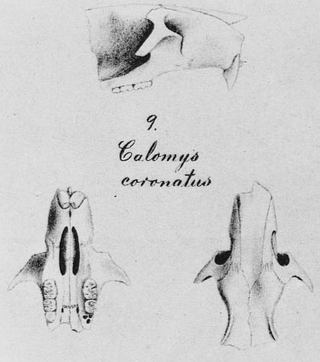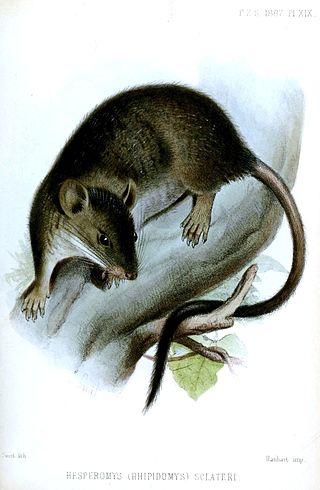
The rodent subfamily Sigmodontinae includes New World rats and mice, with at least 376 species. Many authorities include the Neotominae and Tylomyinae as part of a larger definition of Sigmodontinae. When those genera are included, the species count numbers at least 508. Their distribution includes much of the New World, but the genera are predominantly South American, such as brucies. They invaded South America from Central America as part of the Great American Interchange near the end of the Miocene, about 5 million years ago. Sigmodontines proceeded to diversify explosively in the formerly isolated continent. They inhabit many of the same ecological niches that the Murinae occupy in the Old World.

Oxymycterus is a genus of rat-like rodents commonly known as hocicudos. They are endemic to South America. As of April 2019, the genus contains the following 16 species:
Hylaeamys laticeps, also known as the Atlantic Forest oryzomys or the large-headed rice rat, is a species of rodent in the family Cricetidae.

Euryoryzomys russatus, also known as the russet oryzomys, russet rice rat, or big-headed rice rat, is a species of rodent in the family Cricetidae. It is a member of the genus Euryoryzomys, which was split off from Oryzomys in 2006. It was first described by Johann Andreas Wagner in 1848. It is found in southern Brazil, eastern Paraguay and northeastern Argentina. It is considered a large species in its genus, with a reddish-brown coat, long tail length, and large skull. It is a terrestrial rodent, spending its time foraging for seeds, fruits, and insects. It is listed by the IUCN as least concern, although studies have shown it to be influenced by anthropogenic disturbances. Predators consist of small members of the order Carnivora.

Oligoryzomys nigripes, also known as the black-footed colilargo or the black-footed pygmy rice rat, is a rodent in the genus Oligoryzomys of family Cricetidae. Oligoryzomys nigripes is a species that has been further divided into different sister taxa throughout history. It is found in different countries in South America. It is a large species with long ears, dark yellow to dark brown upperparts, sharply delimited from the whitish underparts, and often a pink girdle on the chest. This species of rat spends much of its life among the trees. The karyotype is 2n = 62, FNa = 78–82.
The lesser Wilfred's mouse is a species of South American rodents of the family Cricetidae. It was first described by Wilfred H. Osgood under the name Thomasomys pictipes, then into the genus Wilfredomys, and now known as Juliomys pictipes. The lesser Wilfred's mouse is endemic to northeastern Argentina and southeastern Brazil. Its physical appearance ranges from dark brown to light orange coloration and the typical size is small to medium. This species is arboreal, spending most of its time trees and living in the local forests at altitudes from sea level to 2000 m. Currently, this species is listed as Least Concern by the IUCN, but, threats include livestock farming, ranching, and wood harvesting.

The woolly giant rat is a species of large burrowing rodent native to South America. No subspecies are currently recognised. It is the only member of the genus Kunsia.

Rhipidomys is a genus of rodents in the family Cricetidae, The following 25 species of climbing mouse species are currently recognised:

Nectomys is a genus of rodent in the tribe Oryzomyini of family Cricetidae. It is closely related to Amphinectomys and was formerly considered congeneric with Sigmodontomys. It consists of five species, which are allopatrically distributed across much of South America: Nectomys grandis in montane Colombia; Nectomys palmipes on Trinidad and in nearby Venezuela, Nectomys apicalis in the western margins of the Amazon biome, Nectomys rattus in much of Amazonia, and Nectomys squamipes in the Atlantic Forest of Brazil. These species are generally semiaquatic, are normally found near water, and are commonly called water rats.
Neusticomys is a genus of semiaquatic, animalivorous South American rodents in the family Cricetidae.
Oecomys speciosus, also known as the savannah oecomys, arboreal rice rat, or Venezuelan arboreal rice rat, is a species of rodent in the genus Oecomys of family Cricetidae. It ranges over northeastern Colombia and much of Venezuela, including the island of Trinidad. This rodent lives in tropical rainforest and tropical dry forest, including secondary forest and gallery forest, as well as in savanna habitat.

Handleyomys alfaroi, also known as Alfaro's rice rat or Alfaro's oryzomys, is a species of rodent in the genus Handleyomys of family Cricetidae. It is found in Belize, Colombia, Costa Rica, Ecuador, El Salvador, Guatemala, Honduras, Mexico, Nicaragua, and Panama. It was previously included in Oryzomys as Oryzomys alfaroi. Its natural habitats are subtropical and tropical lowland or montane dry forests at elevations ranging from sea level to 2500 m.
Hylaeamys megacephalus, also known as Azara's broad-headed oryzomys or the large-headed rice rat, is a species of rodent in the genus Hylaeamys of family Cricetidae, of which it is the type species. It is found mainly in lowland tropical rainforest from its type locality in Paraguay north through central Brazil, French Guiana, Guyana, Suriname, and Venezuela onto Trinidad and Tobago. To its west and east, other closely related species of Hylaeamys are found: H. perenensis in western Amazonia, H. acritus in Bolivia, and H. laticeps and H. oniscus in the Atlantic Forest of eastern Brazil.
Handleyomys rhabdops, also known as the highland oryzomys or striped rice rat, is a species of rodent in the genus Handleyomys of family Cricetidae. It is nocturnal and is found in Guatemala and Mexico in montane forest at elevations from 1250 to 3250 m.
Handleyomys rostratus, also known as the long-nosed oryzomys, long-nosed rice rat, or rusty rice rat is a species of rodent in the genus Handleyomys of family Cricetidae. It is found in Belize, El Salvador, Guatemala, Honduras, Mexico, and Nicaragua. It is nocturnal and is found in forests at elevations above sea level to 1200 meters. Handleyomys rostratus attains its highest level of development in south and Central America. High rates of deforestation and habitat destruction are the biggest threat to Handleyomys rostratus.
Handleyomys saturatior, also known as the cloud forest oryzomys or cloud forest rice rat, is a species of rodent in the genus Handleyomys of family Cricetidae. It is found in Belize, El Salvador, Guatemala, Honduras, Mexico, and Nicaragua in cloud forest at elevations from 750 to 2500 m. It was previously placed in the genus Oryzomys.
The montane Atlantic Forest rat is a South American rodent species of the family Cricetidae. It is endemic to part of the Atlantic Forest region of southeastern Brazil, where it is found at elevations from 1000 to 2700 m in noncontiguous mountain ranges. Its karyotype, like that of closely related Delomys dorsalis, has 2n = 82, but the fundamental numbers of the two species differ. While it is not thought to be in present danger of extinction, habitat destruction and grassland fires are considered to be threats.
In mammals, ungual tufts are tufts of hairs at the base of claws of the forefeet and hindfeet. Their presence has been used as a character in cladistic studies of the Cricetidae, a large family of rodents.
Scapteromys is a genus of South American rodents in the tribe Akodontini of family Cricetidae. Three species are known, found in northern Argentina, southern Brazil, Paraguay and Uruguay. They are as follows:








